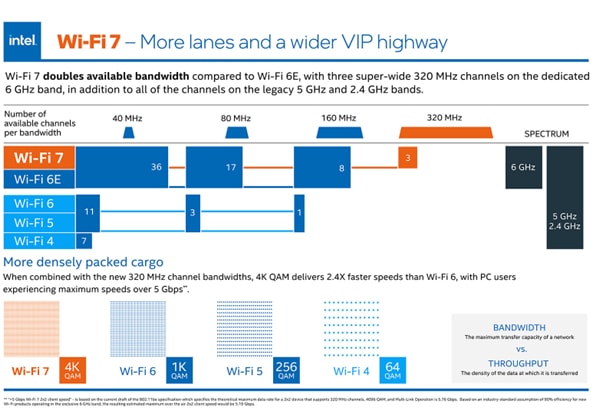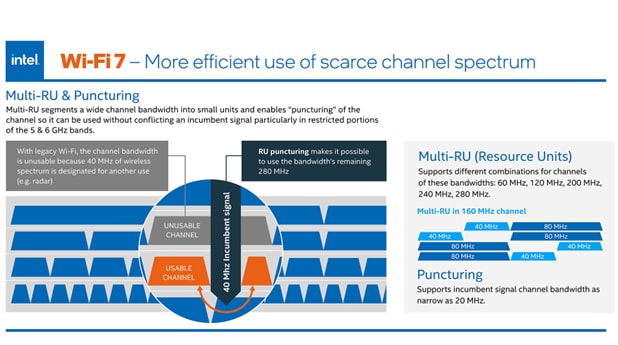Wi-Fi 7: The Next-Level Standard
How Enhanced Features Will Increase Productivity

Image Source: Dzmitry/Stock.adobe.com
By JJ Delisle for Mouser Electronics
Published September 15, 2023
Every few years, the Wi-Fi Alliance builds upon its long legacy of wireless communications and issues a new Wi-Fi® standard/specification. The most recent specification release, Wi-Fi 6E (IEEE 802.11ax) in 2022, introduced an extended 5GHz spectrum and a host of new features. For 2024, the Wi-Fi Alliance has much the same planned, with a new IEEE 802.11 standard, 802.11be Extreme High Throughput (EHT)—also known as Wi-Fi 7—which will also introduce new spectrum, extend bandwidths, and bring several new features to the Wi-Fi universe. The initial draft of Wi-Fi 7 was released in March 2021, with a final draft expected in early 2024.
According to the Wi-Fi Alliance:
Based on the developing IEEE 802.11be standard, Wi-Fi 7 will be the next major generational Wi-Fi technology evolution. Wi-Fi 7 focuses on physical (PHY) and medium access control (MAC) improvements capable of supporting a maximum throughput of at least 30Gbps to increase performance, enable Wi-Fi innovations, and expand use cases. Additional Wi-Fi 7 enhancements will support reduced latency and jitter for time-sensitive networking applications, including AR/VR, 4K and 8K video streaming, automotive, cloud computing, gaming, and video applications, as well as mission-critical and industrial applications. As with other Wi-Fi generations, Wi-Fi 7 will be backward compatible and coexist with legacy devices in the 2.4, 5, and 6GHz spectrum bands.[i]
This article aims to educate readers about the Wi-Fi 7 standard and describe what to expect from Wi-Fi 7 devices, which are likely to start being released in late 2023 or early 2024 (though the final Wi-Fi 7 standard likely won't be finished until sometime in 2024).
Wi-Fi 7 Specifications
As expected, Wi-Fi 7 builds on the capabilities of past Wi-Fi versions but continues the progression of increased bandwidth, deeper modulation schemes, and critical advances. Beyond simply greater data rates, Wi-Fi 7 is also introducing several features that enhance reliability and latency for priority applications. This section will focus on the core features of the Wi-Fi 7 standard and other features that may make their way into Wi-Fi 7 (or future Wi-Fi standards).
Core Features
The core features of Wi-Fi 7 are 4096 quadrature amplitude modulation (4K-QAM), extended-frequency 6GHz band, additional higher-bandwidth modes, multi-link operation (MLO), and multi-resource unit (Multi-RU) puncturing.
4K-QAM
The new 4K-QAM modulation scheme allows for 12 bits to be carried in each symbol as opposed to the 10 bits-per-symbol capacity of 1024 QAM (1K-QAM). This deeper mode of modulation provides a 20 percent boost in theoretical transmission rates compared to Wi-Fi 6 with 1K-QAM. Moreover, Wi-Fi 7 will be capable of spatial multiplexing over sixteen spatial streams.
Enhanced Bandwidth
Standard IEEE 802.11b will introduce additional contiguous and non-contiguous bandwidth modes of 320/160+160MHz and 240/160+80MHz. The 320MHz bandwidth modes exceed Wi-Fi 6 by double the bandwidth availability. The extended bandwidth modes combined with 4K-QAM will result in maximum data rates for a single-user device of 5.8Gbps. This is 2.4 times the 2.4Gbps maximum data rate of Wi-Fi 6E. The combined higher-order modulation, enhanced bandwidth, and spatial streams should allow for theoretical maximum throughput beyond 30Gbps for Wi-Fi 7. This is a leap of several times the maximum throughput for Wi-Fi 6E, which is 9.6Gbps (Figure 1).

Figure 1: Wi-Fi 7 offers many benefits over previous versions, including an enhanced modulation scheme. (Source: Intel®[ii])
Multi-link Operations (MLO) & Deterministic Latency
A primary limitation of Wi-Fi has historically been the standard's lack of determinism and unreliable latency that is also generally too high for more critical operations and low-latency applications. In the past, legacy Wi-Fi standards allowed a device to connect only over a single channel and would use secondary channels as backups if the first channel disconnected. With Wi-Fi 7, the alliance intends to change that with MLO and deterministic latency. This works because the MLOs ensure that the high-priority data is transmitted without any additional delay, which is done by assigning data flows based on specific application requirements. Example applications include virtual reality/augmented reality (VR/AR) and industrial Internet of Things (IIoT), autonomous mobile robots (AMRs), and automated logistics installations.
Currently, there are two facets of MLO: enhanced multi-link single-radio (eMLSR) and multi-link multi-radio (MLMR). eMLSR uses multiple radio link capable access points that can communicate over multiple spatially multiplexed channels (at least a 2×2 MIMO radio on the single-radio user device) to a single-radio device. In this way, one of the channels can be kept free to ensure reliability and minimize latency for high-priority applications while also serving lower-priority but possibly high-throughput applications on the other channel. MLMR works if both the access point and user device have concurrent dual-radio capability. Then, both radios can connect and communicate over both spatially multiplexed channels simultaneously. These radios can also better ensure greater reliability and lower latency if the data is shared redundantly over both channels or can be used to deliver higher throughput through aggregation. This approach is supposed to deliver a maximum of 1/100th of the latency compared to previous Wi-Fi generations.
Multi-RU Puncturing or Flexible Channel Utilization
Past Wi-Fi standards would close out an entire bandwidth channel if it were being used by a single device, even if that device wasn't using the channel fully. This could create scenarios where the high-bandwidth and high-speed channels were being held by devices that didn't require the entire channel's capability. Now, with Wi-Fi 7, the alliance is working on multi-RU puncturing, which subdivides the high-speed channels, allowing them to be used simultaneously by multiple devices as long as there is available bandwidth (Figure 2). This is especially valuable in the 5GHz and 6GHz bands, where an incumbent signal may dominate some of the channel bandwidth, and legacy Wi-Fi devices would have to consider the entire channel as occupied.

Figure 2: Multi-RU puncturing allows for more efficient use of scarce channel spectrum. (Source: Intel®[ii])
Candidate Features
Additional theoretical Wi-Fi features may make their way into the Wi-Fi 7 standard through a later update, if not in the initial release. These features include multi-access point coordination, allowing for coordinated/joint transmission. This technology may further enhance the reliability and reduce the latency of high-priority data streams. Another potential feature to improve reliability is hybrid automatic repeat request (HARQ), which should strengthen the link adaptation and retransmission protocol. Wi-Fi 7 may also integrate Time-Sensitive Networking (TSN) from IEEE 802.1Q for low-latency/real-time applications, as well as IEEE 802.1AS timing and synchronization features. Other IEEE 802 features that Wi-Fi 7 may incorporate are 802.11aa MAC enhancements for robust audio-video streaming, 802.11ak enhancements for transit links within bridged networks, 802.1Qav credit-based bounded latency, 802.1Qch/Qbv cyclic/time-aware traffic shaping, 802.1Qcr-2020 asynchronous traffic scheduling, and 802.11ax scheduled operation extensions for reduced jitter/latency.
The potential features show that the significant goals of the Wi-Fi 7 release are to enhance reliability, lower latency, and realize greater determinism in the Wi-Fi communication links. This is likely a run at competing conductive networking solutions and to position Wi-Fi as a competitive service to 5G ultra-reliable low-latency communication (URLLC) features, which are poised to enable a host of applications in automated applications.
Early Wi-Fi 7 Devices: Features & Likely Specs
The 802.11be Task Group is led by members of Qualcomm, Intel, and Broadcom, with representatives from MaxLinear, NXP, and more holding senior positions. This task group is composed predominantly of chipset manufacturers, who benefit from the advanced notice of standards development in their product development cycles. Though the standard is still not final, there are already Wi-Fi 7 chipsets being used in early demonstrations and beta releases. Thus, there will likely be Wi-Fi 7 chipsets available in 2023 so that Wi-Fi access points and user equipment manufacturers can access chipsets before the release of the Wi-Fi 7 standard. Early Wi-Fi 7 chipsets will likely have all the core features predicted for Wi-Fi 7. They may include some candidate features or provisions for enabling those features with software or configurable hardware in the future via software updates.
These features include 320MHz bandwidth channels, 2.4GHz/5GHz/6GHz frequency bands, 4K-QAM, and sixteen spatial multiplexing streams. Qualcomm has listings for their Wi-Fi 7 products, including a networking device chipset—Networking Pro 1620 Platform—that advertises a Wi-Fi peak PHY rate of up to 33Gbps. The product brief for this chipset also advertises MLO/deterministic latency features and multi-RU puncturing. Therefore, it is likely that the other chipset manufacturers will also launch with these features. Most chipset manufacturers will likely include additional features, including networking interface, user architecture, and security features.
Conclusion
Wi-Fi 7 chipsets, and hence devices, are currently in development and will likely be released along with the Wi-Fi 7 standard release. The new features coming to Wi-Fi 7 enable far more than just faster link speeds but also focus heavily on reliability, low latency, and determinism.
Sources:
. Wi-Fi Alliance “Current Work Areas.” Accessed August 30, 2023. https://www.wi-fi.org/who-we-are/current-work-areas.
[ii]
. “What Is Wi-Fi 7?” Intel Corporation. Accessed September 5, 2023. https://www.intel.com/content/www/us/en/products/docs/wireless/wi-fi-7.html.